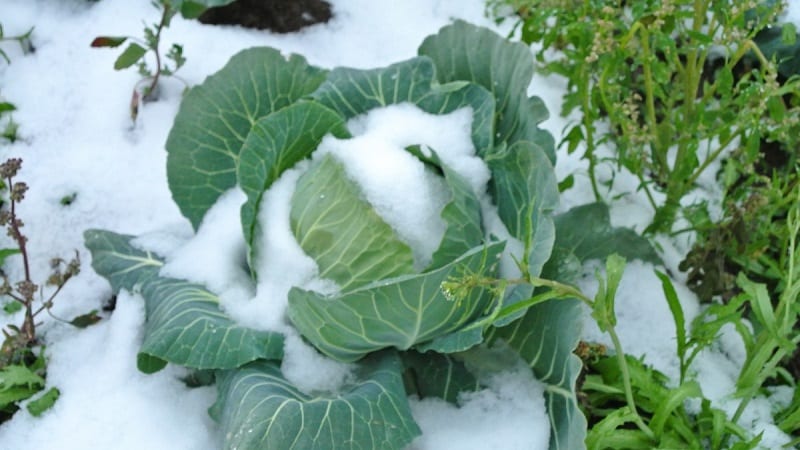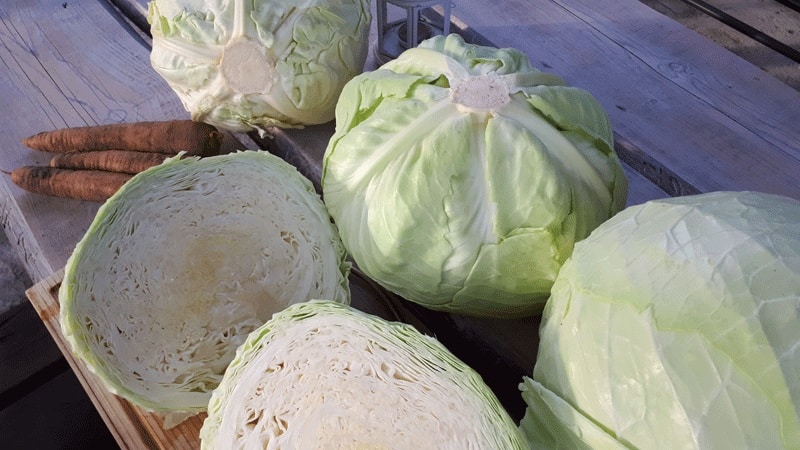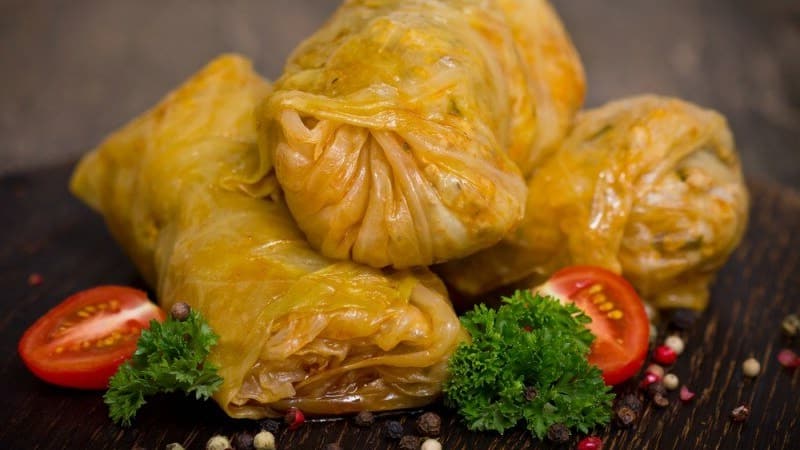What to do if the cabbage is frozen
Cabbage is harvested from the beds later than other vegetables. Light frosts often do it good: the leaves become sweeter and tastier when pickled. But it often happens that the weather forecast turns out to be incorrect, the thermometer drops significantly below zero, and the vegetables freeze heavily. However, even in this situation, cabbage can be eaten. What to do if it is frozen in the garden and how to remove it, you will learn from the article.
What to do if cabbage is frozen
Even frozen cabbage does not lose taste. It, like fresh, is suitable for preparing first and second courses, and in some cases it will even cook faster (for example, when stuffing cabbage rolls).

There are fewer worries with cold-resistant cabbages: They easily tolerate frosts down to -5°C. Therefore, do not rush to remove them from the garden in warmer weather. But already cut cabbage is more tender, and such low indicators are not suitable for it. But any cabbage cannot withstand repeated exposure to low temperatures, so do not expect that, once frozen, the cabbage will become stronger.
Loose heads of cabbage are more resistant to cold, dense ones freeze stronger and faster. The reason is the layer of air inside. It serves as a thermal insulator and helps retain more heat.
How to properly remove frozen cabbage
If the head of cabbage is frozen on the vine, don’t rush to cut it off. If the weather forecast predicts even slight warming, wait a day. The vegetable will thaw on its own. If the cabbage has already been affected by frost, do not wait.She won't get any better.
Inspect the heads of cabbage affected by the cold. If the top few leaves are frozen, separate them with scissors and place them to thaw in a cool room in a convenient box with a cardboard bedding. Don't forget to check from time to time to see if the head of cabbage has started to rot. Store forks It’s better not to pile one on top of the other, but to lay it out in 1-2 rows and sprinkle it generously with crushed chalk.
Frozen vegetables are stored in paper, not newspaper paper, but clean paper, without drawings.. It will prevent the vegetables from drying out. You can hang 2 heads of cabbage from the ceiling. Pierce the stalks and pass rope or twine through the holes. Insert a sheet of thick paper between the heads of cabbage.
Another storage option is in large boxes with river sand.. Select containers of suitable size and add a few centimeters of sand to the bottom. Cut off the top 3-4 leaves of the heads of cabbage. Place the vegetables with their stalks in the sand. Spray the sand with water from a spray bottle from time to time.

Some gardeners even preserve culture in the ground. To do this, a long trench is dug in the ground, its bottom is covered with a layer of fresh straw (5-8 cm). The cabbage is laid stalks up in one layer and covered with clean sand on top.
It is important that the heads of cabbage do not touch each other. This will save vegetables from massive rotting. Dry manure is poured onto the sand, followed by a thin layer of soil.
Attention! If you are afraid that mice or rats will damage your vegetables, use regular pine needles. Place a thin layer on the bottom under the cabbage and on top of the sand.
If the cabbage is very frozen, thaw it in 2 stages.. First, put it in a cool room with a temperature of +1...+5°C for 2-3 days, and then in a warmer room - +10...+15°C. It is advisable to put this cabbage into use as quickly as possible.
If 2-3 leaves of a head of cabbage are frozen, it will be stored for more than 3 months, 5-6 sheets – no more than 2.5-3 months. If the core is frozen, throw away the head of cabbage without regret. Once in the heat, it will begin to rot. This vegetable is not safe to eat even after heat treatment.
Cabbage should not be planted in lowlands or on heavy soil.. In such places, the temperature is always several degrees lower than on the plain, and the moisture stagnates. Care is also important. If you feed the seedlings in time and destroy pests, the cabbage will be healthy and strong, and there will be less damage from frost.
What to do with frozen cabbage
Frozen cabbage can be fermented. If the top leaves of a head of cabbage are damaged, they are torn off and the forks are used for their intended purpose. But if it has been frozen more than once, a tasty vegetable preparation will no longer be possible. The shredded pieces will be limp, soft, and will begin to crumble into an unappetizing porridge. And the process of rotting in the mass will begin quickly.
Sauerkraut maybe in quarters (in halves), small pieces or shredded. The smaller the portion, the faster it will ferment. If there is not enough juice during the process, add 0.5 tbsp to the pan. salted water.

Frosted leaves will make soft and tasty cabbage rolls. The leaves do not need to be doused with boiling water: they are already tender. Fry the onion and boil the rice, mix everything with salted minced meat, wrap the finished mixture in leaf envelopes and place in a frying pan. Pour tomato sauce over the finished dish.
Reference. Many cooks prefer to make cabbage rolls from frozen cabbage leaves: they do not break during the process.
Frozen cabbage is also suitable for making borscht. There is no need to change anything in the recipe, but it should not be exposed to prolonged heat. The cabbage will fall apart into unappetizing fibers. Boil the potatoes, and then, reducing the heat, add the chopped vegetable.
Pancakes, solyanka, a side dish for cutlets or potatoes - frozen cabbage is suitable for all of these dishes. It is also prepared in batter. Boil the leaves, roll them into a tube or envelope, coat them thickly with batter and fry in plenty of sunflower or olive oil.
Attention! But salads made from frozen cabbage will turn out tasteless.
Conclusion
Now you know what to do if it’s frozen, but you didn’t have time to remove the cabbage. Do not rush to throw away or feed such heads of cabbage to livestock. Even a spoiled harvest can be partially preserved, or the vegetable can be used to make delicious borscht, cabbage rolls or pies.